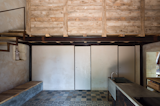An Old Olive Oil Mill in Sicily Is Recast as a Charming Cottage
Casa Farfaglia, as it’s known today, has lived many lives since being built in the 1890s. The stone structure first served as an olive oil mill and a stable for livestock, and then became a holiday home up until the 1950s. Recently, the historic building was treated to yet another transformation—this time by local firm Studio Gum.
"Casa Farfaglia is a typical example of rural architecture in the Val di Noto region," state Gum architects Valentina Giampiccolo and Giuseppe Minaldi. "These buildings had the double characteristic of being both a workplace that was related to the rural world, and housing for short or long periods."
The current owners were seeking to redesign the property into a private residence for themselves and their two daughters, while also creating a guest house for short-term rentals. "Since the very beginning, they also stressed the importance of preserving the characteristics of the building, so much so that it has become almost a landmark for all the generations who have lived in the area—like a millennial monolith," states the team.
Perched on a sprawling hillside in southeastern Sicily, the home blends into a natural setting complete with dry stone fences and Mediterranean scrub. To conceal newly added structural concrete curbs which enhanced building support, native vegetation was planted along the underside of the roof tiles. "The steel element flows seamless," say the architects, "even on the inclined sides of the roof pitches where the tasca and the gutter disappear, while the casing that shields the curb remains."
The interiors follow the same design approach: The original functional layouts have been maintained, while needs for practical living and technology have been addressed.
The interior area which used to house the mill now serves as the primary living room. To pay tribute to the building’s past, the team left a circular trace on the floor where stone wheels formerly pressed olives. "It is in this area where a large chimney—which hangs from the ceiling and is suspended from the brazier—comes to life," says Studio Gum.
Shop the Look
A load-bearing wall that separates the living area from the kitchen maintains its original doorways, keeping intact the passages that were originally used to transport olives from a storage area to the milling room.
The residence features two bedrooms: one on the main floor and another in the upstairs loft area. "The core of the loft—which is entirely self-supporting thanks to structure beams and HEA pillars—is visible both from the bedroom on the ground floor and from the kitchen."
Learn more about Casa Farfaglia, or book your own stay at the guest house via the Airbnb listing.
Related Reading:
A Restored Stable in the Italian Alps Embraces Its Unparalleled Landscape
Clean, Precise Interiors Complement the 17th-Century Shell of an Italian Seafarer’s Apartment
Project Credits:
Architect of Record: Studio Gum / @studiogum
Landscape Architects: BB Paesaggio
Additional Collaborators: Paola Licitra & Marco Scebba
Construction: Noto Restauri
Other: Vivaio_Pollice Verde Ragusa & Opere in Ferro
Photography: Filippo Bamberghi / @filippobamberghi
Published
Last Updated
Get the Renovations Newsletter
From warehouse conversions to rehabbed midcentury gems, to expert advice and budget breakdowns, the renovation newsletter serves up the inspiration you need to tackle your next project.




















